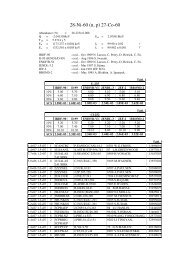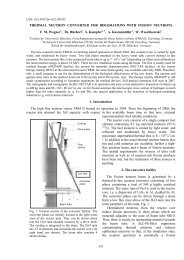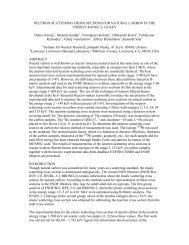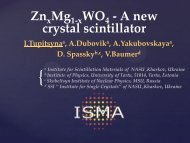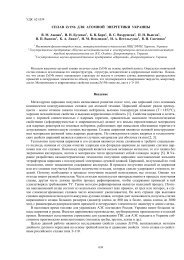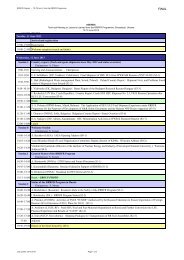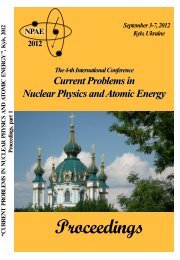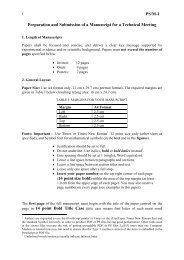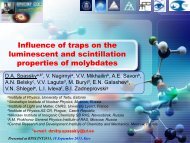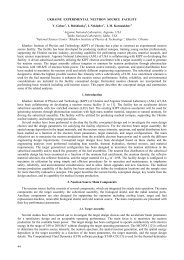International Reactor Dosimetry File 2002 - IAEA Publications
International Reactor Dosimetry File 2002 - IAEA Publications
International Reactor Dosimetry File 2002 - IAEA Publications
Create successful ePaper yourself
Turn your PDF publications into a flip-book with our unique Google optimized e-Paper software.
more sensitive than volume effect devices to ionization radiation effects<br />
produced by either a neutron field or a mixed neutron–gamma field.<br />
The accepted methodology is to relate the damage caused by a specific<br />
fluence of a given neutron spectrum to an equivalent fluence from a monoenergetic<br />
spectrum at a reference energy that would produce the same level of<br />
damage. 1 MeV is the reference energy used by the semiconductor radiation<br />
effects community, and the ratio of the fluence from a specific neutron with<br />
energy E to the fluence of a reference 1 MeV neutron required to cause the<br />
same level of damage is referred to as the 1 MeV(Si) damage response<br />
function. IRDF-<strong>2002</strong> response functions include the results of the calculation<br />
of silicon displacement kerma factors (displacement kerma per unit neutron<br />
fluence) as a function of neutron energy over the range 10 –10 –20 MeV. The unit<br />
of the displacement kerma factor is megaelectronvolts times millibarns<br />
(MeV·mb). Each factor can be multiplied by 3.435 × 10 –13 to convert to<br />
rad(Si)·cm 2 , or by 3.435 × 10 –19 to convert to J·m 2 /kg or Gy(Si)·m 2 .<br />
An average value of the neutron displacement kerma factor near 1 MeV<br />
is difficult to determine because of sharp neutron cross-section resonances in<br />
that energy region. To avoid these difficulties, the semiconductor radiation<br />
effects community has defined the displacement kerma of a reference 1 MeV<br />
neutron to be exactly a reference displacement kerma level of 95 MeV·mb.<br />
Values for the silicon displacement kerma are determined by calculating the<br />
total kerma and then partitioning the data into ionization and displacement<br />
fractions [8.7]. The correlation of the displacement kerma with the measured<br />
damage in many neutron fields has been confirmed with integral uncertainties<br />
no larger than 10% [8.8]. Figure 8.2 shows the neutron energy dependent<br />
silicon displacement kerma.<br />
For any given neutron spectrum, a 1 MeV(Si) equivalent fluence is<br />
derived by convoluting the displacement kerma with the neutron spectrum and<br />
dividing by 95 MeV·mb. The uncertainty in the specification of the neutron<br />
spectrum should be propagated through this convolution and used to<br />
determine the uncertainty in the resulting 1 MeV(Si) equivalent fluence. Note<br />
that the displacement kerma is considered to be a radiation effects community<br />
specified exposure metric and has no uncertainty (i.e. it represents a specified<br />
response).<br />
8.3. GALLIUM ARSENIDE dpa (ELECTRONICS DAMAGE)<br />
The basis of the currently accepted protocol for the correlation of<br />
neutron damage effects to a neutron fluence in a GaAs semiconductor device is<br />
through the displacement kerma produced in bulk GaAs. However, this<br />
94



